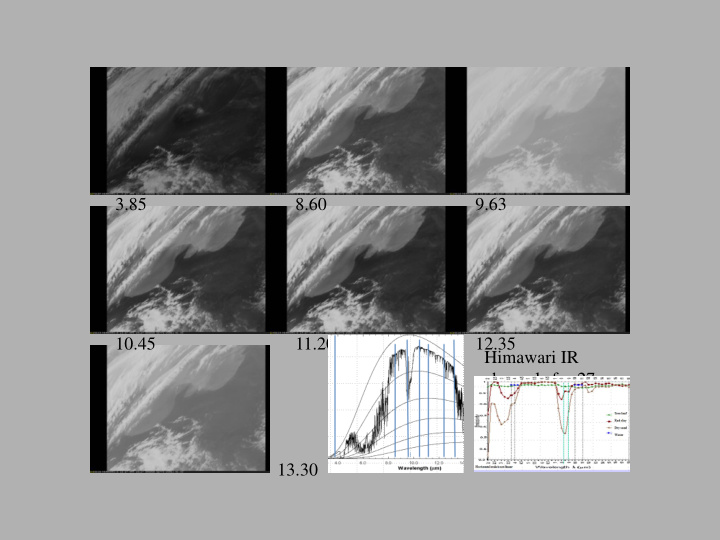



3.85 8.60 9.63 10.45 11.20 12.35 Himawari IR channels for 27 April 2015 case. Wavelength in microns 13.30
P P P C C C 2 1 3 P P P C C C 4 5 6 Principal component (PC) images from pure IR channels only (i.e. 3.9 microns not used and no water vapor channels). Upper left to lower right: PC images 1-6 and RGB of PC 1,2,3 then PC 1,2,4
Advanced Himawari Imager Examples Animations of the dust case just presented, but from two different viewing perspectives, with Himawari-8 imagery at 10 minute intervals on the left and FY-4 with three minute intervals on the right. While the animations overlap in time, they do not cover the same time period (himawari-8 covers a longer time period). The image sizes also differ, with FY-4 covering a larger area than Himawari-8.
Clicking on the total precipitable water (tpw) movie will start or stop animation. Notice how well the tpw product depicts the ITCZ as well as shows the interaction between tropical and mid- latitude systems.
Click to stop animate
Hurricane Bonnie’s warm core revealed in temperature anomaly cross section derived using NOAA-15 Advanced Microwave Sounding Unit (AMSU) data
Today, we have entered an age of multiplatform, multi Microwav sensor products to aid in e the analysis of tropical depiction storms and hurricanes of warm core anomaly and rain rate
Winds, SST, Microwave anomaly and Altimetry GOES Rapid Scan 164
Then along came Floyd It will be important to monitor such disasters at very high resolution to follow ocean pollution Ocean color showing result of flooding interacting with pig farms. You want to be able to make daily cloud free images of this consequence of a natural disaster immediately and blend with SST, ocean currents and other information.
One month later the ocean water is much clearer
Active sensors • Active sensors from research satellites are used to measure various sea surface properties (altimetry, wind speed and direction, ice field characteristics as well as ice berg tracking). The are also used to measure rainfall over water or land. Many of those products are available for use by NMHS’.
Altimetry Right: Sea level anomaly over Gulf of Mexico from satellite altimetry. To the left are maps of sea level anomaly over the equatorial Pacific showing the increase in sea level off the west Coast of South America accompanying the onset of el Nino.
Example of global wind coverage from QuikSCAT for April 1 2005. The time 20:58 UTC in the top legend indicates the most current pass in the product.
SAR Wind Speed Product Oct 25, 1999 16:37 GMT Wind Speed (m/s) 0 5 10 15 20 25
SAR Iceberg Tracking and monitoring of ice shelf edge and sea ice
TRMM radar cross sections, from NASA/GSFC web site.
Atmospheric Dynamics Mission (ADM) Active Doppler wind lidar for determination of atmospheric winds (also aerosols). Flies in a dawn/dusk orbit
This concludes the lecture on Spectral Bands and their Applications • More information on spectral bands and their applications may be found by using Internet go to the WMO web site and access the WMO Space Program to link to the Virtual Laboratory.
How we display the data (imagery) becomes exceptionally important since the spatial and temporal domains of the atmospheric phenomena being observed (or oceanographic and terrestrial) should dictate the spatial, spectral and temporal domains of the satellite imagery used to view and analyze that phenomena. Among the topics to be addressed are using stereo, feature relative motion and image averaging to extract meaningful information.
Earth relative animation of one minute interval visible data Severe reports, red is tornado, blue and green hail and damaging winds
Storm relative animatio n of one minute interval visible data
Earth relative animation of one minute interval infrared data 33 minutes in length
Average of 33 minutes of Earth relative infrared imagery from animation just shown
Storm relative animation of one minute infrared data 33 minutes in length
Average of 33 minutes of storm relative infrared imagery from animation just shown
Earth relative average of 33 minutes of infrared imagery for comparison with storm relative average just shown
3 minute running mean loop made from infrared storm relative imagery
Stereo example remapped GOES-16 image
Stereo example remapped VIIRS image
Holding cloud streets south of storm system stationary reveals that they are lower than high based cumulus to the west of the storm
Holding cloud streets south of storm system stationary reveals that they are lower than high based cumulus to the west of the storm
375 meter resolution VIIRS visible image Let’s go beyond here next with our geostationary systems
375 meter resolution VIIRS infrared image Let’s go here next with our geostationary systems
We have briefly addressed Principal Component Analysis, viewing rapid scan imagery in an Earth Relative and Storm, or Cloud Relative Mode, and Averaging Image Sequences to Help Diagnose Storm System Characteristics. • These effect the way we approach data handling, science, product development, training and utilization. • We must now think in terms (investigate and develop) of new multi-channel products, derived from mathematical analysis, at frequent intervals to be used in specific application areas. • Numerous product areas, such as precipitation estimation, cloud motion vector derivation, feature tracking, severe storm identification and nowcasting in general will benefit from these advanced analysis methods. • How we display the data (imagery) becomes exceptionally important since the spatial and temporal domains of the atmospheric phenomena being observed (or oceanographic and terrestrial) dictate the spatial, spectral and temporal domains of the satellite imagery used to view and analyze that phenomena.
Recommend
More recommend